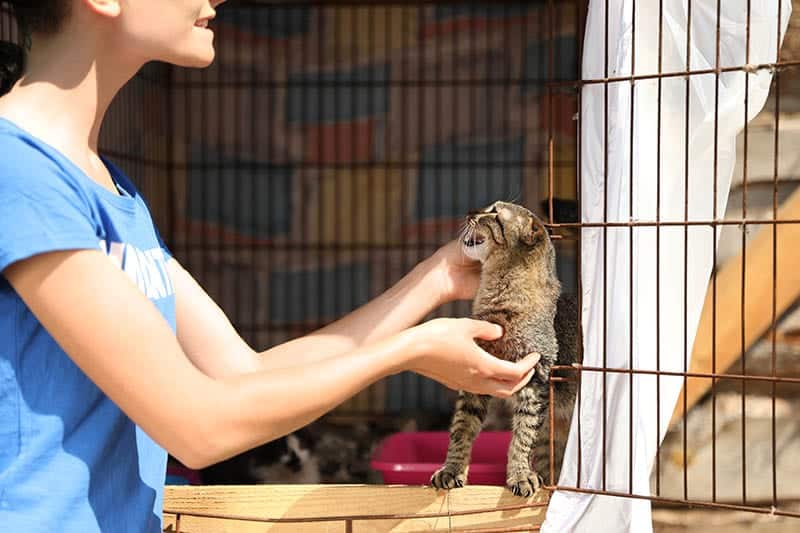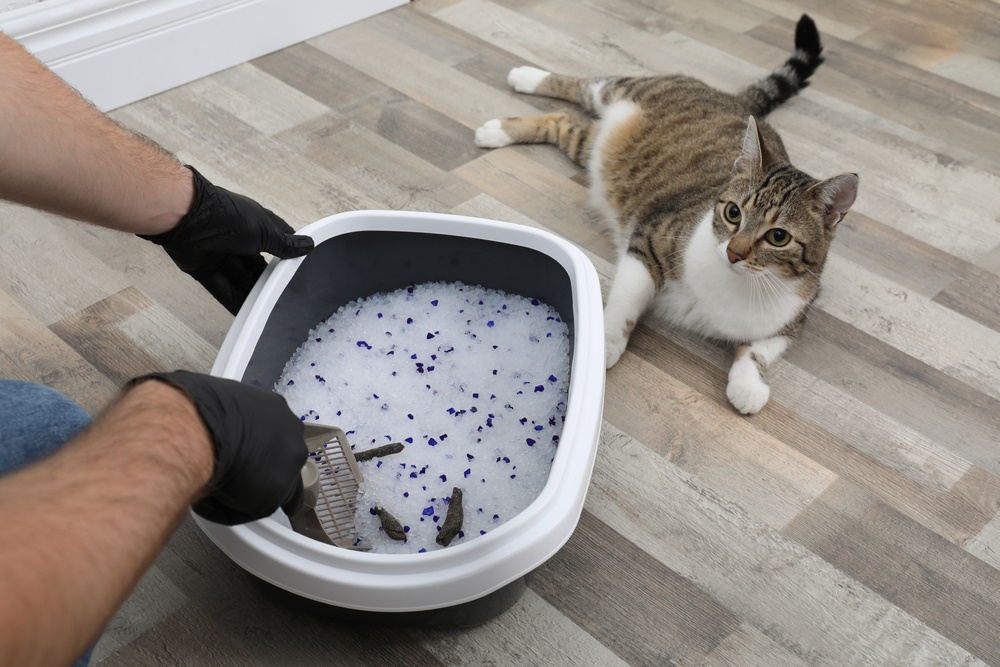Click to Skip Ahead
Have you ever interacted with a feral cat? “Interacted with” might not be the right wording, as feral cats will often not let you get close to them, let alone let you touch them. In fact, a feral cat might run away should you even make eye contact or any sudden movements! So if they are coming close and showing an interest in you, it is more likely that you are dealing with a stray cat.
Although it takes time and patience, you can calm a stray or sometimes, but not often, even a feral cat so they’re more relaxed around you and other people. This article goes over information about these cats and the steps involved with calming a feral feline that’s not used to being around people.
Please be mindful that stray and feral cats will scratch and bite if they feel threatened or trapped, and it may be illegal in some states to feed them. Contact your local animal shelter or vet clinic for more specific advice.

What Is the Difference Between Feral Cats & Stray Cats?
A stray cat is a domestic feline that used to be someone’s pet and is generally comfortable around people, to a varying degree. They may have gotten lost or were abandoned but are socialized around people and will often see them as a source of food. Some will approach certain people that feed them, or even move in with a new family, while others may be more timid.
A feral cat has not been socialized with people, either due to being born to a stray or feral mother, or due to other circumstances preventing them from having close contact with people during the first few months of life. They can’t be easily approached as they are fearful or even defensive towards humans, they do not rely on them, all because they have had little to no contact with people and are basically wild.1
There is some disagreement in the field of thought on taming feral cats, and generally, it is a very challenging process that can take years, and will greatly depend on the cat’s personality as well as the professional’s experience. Feral cats will not allow being touched or handled unless they are ill.
Precautions Before Approaching Stray and Feral Cats
As seen above, feral cats are not easily approached and should only be dealt with by professionals. If you have a feral or stray cat visiting your garden, please contact your local animal warden, shelter or rescue organizations, or the vet, and check your local rules and legislation, as it differs greatly between states, and some prohibit feeding feral cat colonies.
If feeding them is not illegal in your jurisdiction, and you want to try and make them less fearful if they are visiting your garden, still consider contacting a professional. It is possible that the cat may be someone’s lost pet. Do not try to trap or catch them as you may risk a serious injury.

The 5 Steps to Calm a Feral Cat
1. Allow the Cat to Make the First Move
Don’t try to force yourself on a feral cat because all you’ll do is scare them. What you should do is give the cat time to make contact with you. When they attempt to come close to you, avoid making any sudden movements and talk to them in a positive way using a soft and gentle voice to assure them that you’re not a threat.

2. Provide Treats & Toys to Encourage Interaction
Once the stray or feral cat comes near you without running off at the slightest movement or sound you make, or returns promptly after they realize all is well, reward them with treats. Make sure all your actions are calm, and keep your voice low.
By offering the cat a tasty treat like a piece of chicken, you’ll begin to earn their trust but remember to only do this if it is legal in your town and state. At this point, the cat may come closer to you and connect on a one-on-one basis. They may choose to sit near you or wander around close to you but do not try to touch them. A truly feral cat is unlikely to come near you for months and sometimes even years, and if the cat you are dealing with is approaching you, they are more likely a stray or the neighbor’s cat.
In the case of unowned stray and feral cats, be mindful that if you do start feeding them, they will begin relying on you as a source of food. Ensure you consider this before you uptake such responsibility that should then be maintained.
3. Help the Cat Get Used to Being Around People
A feral cat will likely become frightened when they hear human conversation, music, doors opening and closing, and other sounds people make. You can try to help a feral cat get used to being around you and others, but they may never get used to it, based on their previous experiences and level of socialization.
A good time to expose a feral cat to human activities is during mealtime. While the cat is busy eating, perform a few slow and deliberate tasks to get them used to the movements and sounds you make. If you’re near your back door or garage with the cat, go in and out of the door, but don’t slam it! Be calm and somewhat quiet, so the cat doesn’t take off and never return.

4. Make a Space for the Cat
Once your new feline friend is getting used to being around you, make a space for them to call their own. This can be anything from a shed with an open window for easy access to a comfy cat bed placed on your porch. Just make sure the space that you create for the cat is clean, warm, inviting, and something that will make the cat feel secure. But be aware that they are not very likely to use if they are genuinely feral, while a stray cat may gladly make it their new home.
5. Spend Time With the Cat
Once the cat has been given time to settle in, start spending some time with the animal in their new space and outside. It’s a good idea to wear long sleeves, pants, gloves, and shoes when you’re around the cat to prevent scratches and bites, but do not try to pick them up or pet them.
Plan on spending time with the cat at the same time each day to establish a routine. Don’t approach the cat too quickly or make loud noises. It’s also wise to avoid making eye contact with the cat so they don’t feel threatened. Sit down, and spend an hour or so with the cat as often as you can, to get them used to you.
It’s a good idea to play with the cat once they feel safe spending time around you. Pick up a few cat toys like a string and feather toy or a plush mouse. Slowly introduce the toy to the cat, so they know that it’s not a threat. Then use the toy to entice the cat to interact with you.


How to Tell If a Cat Is Scared or Aggressive
It’s easier to calm a stray or a feral cat if you know how they feel. You certainly don’t want the cat to attack you with their claws or teeth, but because they can be unpredictable and easily scared, avoid trying to touch them or handle them. You also don’t want to frighten the cat to the point where they head for the hills and never come back.
A frightened cat will hiss and growl to keep you at bay and will try to escape. The eyes of a scared cat are usually big with dilated pupils, and the animal will keep their ears low while hissing and growling in an attempt to scare you away, with raised hackles. The cat’s fur will stand raised so they can make themselves look bigger and more frightening. Most cats in this case will try to escape the potential threat, while they generally turn to aggression if they are trapped or cornered. Never try to catch, trap, or pick up a feral cat, as it’s likely to result in injuries for both you and the cat.
If the feral cat shows signs of aggression when you’re trying to approach them, back off and give them the space that they need—otherwise, you may get hurt.
How Long Does It Take for a Feral Cat to Adjust?
You’re not going to see overnight success when trying to calm a feral cat. The process will take several months, and sometimes even longer, so be patient and careful not to get injured. Remember that the cat may have lived their entire life outdoors without coming into contact with any humans and they may never attempt to approach a human.
Familiarize yourself with the local rules and legislation and contact the local animal rescue organization or the vet before you consider approaching a stray or a feral cat. The stray in your garden may be someone’s lost pet, or it may be a genuine feral cat that is terrified of people and may never come any closer. These cats are not suitable to make a family pet unless they go through a process of socialization with a professional and this may take years to yield a positive result, based on the cat’s age, level of previous contact with people, and past experiences. Young feral kittens have a much better chance of getting adjusted to people and becoming suitable for adoption.

Conclusion
If you cross paths with a feral cat that appears to be scared of people, they were probably born wild. If you want them to be calm and relaxed in your presence, if they are visiting your garden, contact a local animal organization and double-check the rules and regulations in your state. If it’s not illegal to feed them and they are not a stray or someone’s lost pet, you can try to follow these steps and do everything as calmly as possible.
With time, perseverance, and patience, that feral cat may become more comfortable and less frightened around you but do not expect that you will be able to touch or hold them. They are not pets. Don’t forget to give them plenty of time and space and allow them to warm up to you on their terms, but be careful not to get injured!
See also:
Featured Image Credit: JancickaL, Pixabay










